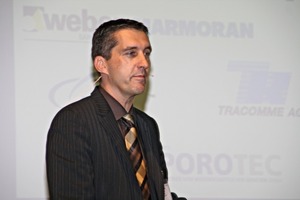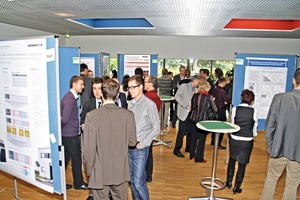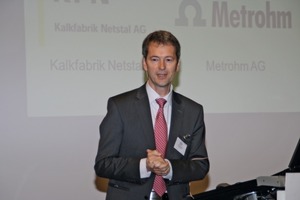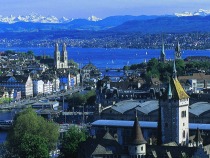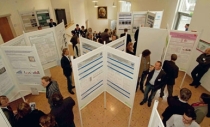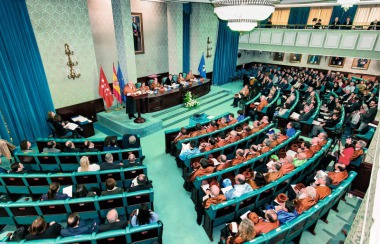Stimulating exchange on construction chemistry
A large number of the around 185 participants met on the evening preceding the conference for an informal get-together in the speakers’ foyer of the venue, the ETH Zurich Technical Academy, taking the opportunity of enjoying the magnificent view of Zurich and Lake Zurich at dusk.
Dr. Hubert Motzet (Fig. 4), Chairman of the Chemistry of Construction Materials Division, welcomed the participants. Dr. Peter Richner, Member of the Empa board and Head of the Civil and Mechanical Engineering department, then presented a number of current Empa projects.
The focal topic of the “Sustainable building materials for the future” Specialist Group was examined in two plenary addresses. Dr. Michael Romer (head of Research & Development at Holcim Group Support, Holderbank) spoke on “Sustainability in the cement and concrete industry”, and Prof. Dr. Horst J. Bossenmayer (President of the IBU Institute for Construction and Environment) focussed on the “Environmental Product Declarations (EPD) – Sustainability requirements resulting from the regulations of the European Parliament and Council”. Further specialist papers on the subject of sustainability followed, from Dr. Thomas Schmidt (Holcim Switzerland), on the use of spent oil shale in cement, and from Florian Deschner (Empa Dübendorf) and Sebastian Dittrich (University of Erlangen), on hydration mechanisms in fly-ash cements.
The event continued after the midday snack with further topical addresses from the field of Research & Development. Jan Bisschop (ETH Zurich) examined the dissolution kinetics of alite and Portland cement, while Sara Mantellato (ETH Zurich) presented her results on the measurement of the specific surface area of fresh cement pastes. The following two lectures discussed the workability of cementitious building materials: Hans-W. Krauss, of the Technical University of Braunschweig, outlined the agglomeration mechanisms of ultrafine particles in cement pastes, while Prof. Dr. Harald Garrecht (University of Stuttgart) illustrated the way in which suitable mixing methods can boost the efficiency of superplasticizers. The next three papers were concerned with the mechanisms of action of organic additives. Dr. Arnd Eberhard (Sika Technology AG, Zurich) spoke on the functioning of shrinkage reducing agents, Dr. Christof Schröfel (TU Dresden) examined the adsorption and desorption mechanisms of superabsorbent polymers in the cement paste, and Dr. Robert Baumann (Dow, Horgen) discussed the use of cellulose ethers in self-compacting concretes. The final address of the day was given by Henrik Funke (TU Chemnitz) on hybrid materials consisting of textiles-reinforced concrete and glass-fibre-reinforced plastic (GRP).
The meeting of members of the Chemistry of Construction Materials Division was then held, followed by dinner at the restaurant “Die Giesserei” (“The Foundry”) in Zurich’s Oerlikon district, the highlight of the evening being the award ceremony for the Chemistry of Construction Materials Division’s advancement prizes. Dr. Ueli Angst, of the ETH Zurich, received the “Best Dissertation” accolade for his work, submitted at the Technical University of Trondheim (Norway), on chloride-induced corrosion of reinforcement steel in concrete. The prize for the best degree/masters thesis was awarded twice, to Iris Paschke and Andrea Winkler, both of the Technical University of Freiberg. To applause from the audience, the Chemistry of Construction Materials Division then took formal leave of its long-standing board member Prof. Dr. Christian Kaps (Bauhaus-University of Weimar).
The next morning, Dr. Sergey Churakov (Paul-Scherrer-Institut PSI, Villigen) delivered a plenary address on the subject of “Crystal chemistry of C-S-H phases from atomistic simulations”. Further addresses on the subject of computer-based methods in construction chemistry then followed: Dr. Andreas Funk (University of Siegen) examined quantum-chemical simulations of surface reactions of calcium hydroxide, after which Sebastian Bergold (University of Erlangen) presented his results on the quantification of C-S-H phases in hydration of alite. Carina Jehn (Technical University of Hamburg-Harburg) focussed on the simulation of an incipient alkali/silica reaction, and Dr. Roger Zurbriggen (Elotex AG, Sempach-Station) spoke on moisture-induced stresses in the concrete/tile adhesive/tile system.
The event’s closing session dealt with analytical and test procedures. Dr. Pavel Trtik (Empa Dübendorf) discussed “Peak-force tapping atomic force microscopy”, by means of which the local modulus of elasticity of hydrated cement can be determined. Prof. Dr. Thomas Bier, of the Technical University of Freiberg, examined the ageing of dry mortars and their mineral components. The winner of the Research Prize, Dr. Ueli Angst, focussed on potential field measurement, which offers more possibilities than simply the location of corroding reinforcement. Dr. Torsten Westphal (Technical University of Freiberg) gave the closing address, on the results obtained by the Rietveld workgroup.
Once again, this year’s event featured an assessment of the posters, supported by Deutsche Bauchemie e.V. A jury of five appraised the posters submitted, selecting the contribution on the topic of “Control of cement hydration using nanoparticles” by Gerrit Land and Dietmar Stephan, of the Technical University of Berlin, as the winner. Second prize was awarded to Iris Paschke (Technical University of Freiberg), while two joint third prizes went to Dr. Pavel Trtik and Axel Schöler (both of Empa Dübendorf).
Dr. Hubert Motzet closed the event. Following the scientific programme, the participants had the opportunity of visiting the Research and Production departments at Sika, in Zurich, or the laboratories of the two Empa “Concrete/Construction Chemistry” and “Building Technologies” departments.
This stimulating and extremely well organised conference once again provided much potential for learning about and discussing current developments in the field of construction chemistry. Lively discussions during the breaks and at the poster exhibition assured ample opportunity for exchange of information and for networking. The next conference which, for the first time ever, will have an international orientation and will be conducted entirely in English, is awaited with great anticipation, and is to be held at the Technical University of Berlin from October 7 to 10, 2013.


